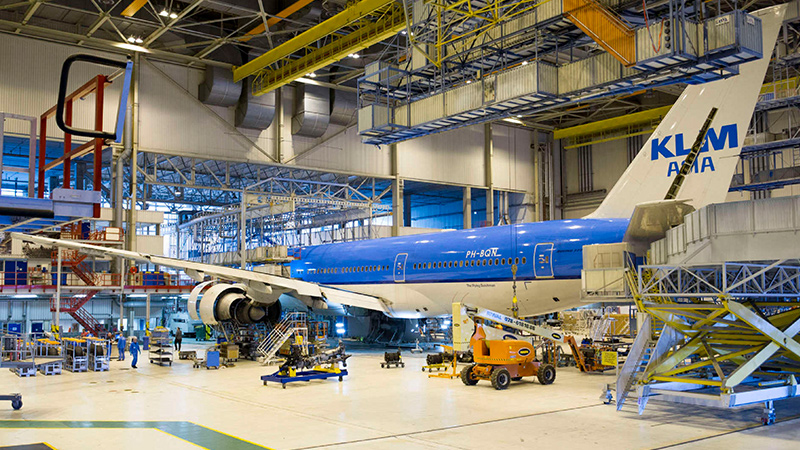Modernizing MRO
January 2018
Companies specializing in maintenance, repair and overhaul of commercial planes are beginning to face competition from the companies that built the planes. How can MRO specialty providers compete? Industry executive Tom Hennessey says it all starts by embracing the concept of the digital thread.
The number of commercial airliners in the world is expected to grow annually for the next 20 years. The maintenance, repair and overhaul market is projected to grow, too, specifically at an annual rate of 5.2 percent between 2022 and 2027. The global fleet will be refreshed over the next 10 years, with half of the 20,000 new planes delivered replacing in-service aircraft; the passenger fleet will net more than 10,000 new planes by 2027. Due to regional differences in air travel, fleets in China and India will continue to age as aircraft are kept in service to meet outsized demand in Asia. In fact, aviation MRO in Asia has boomed in recent years, and the region is under constant pressure to keep up with infrastructure needs. The story is different in developing areas like Africa and the Middle East, where fleets are newer overall. The “2017-2027 Fleet & MRO Forecast” by the Oliver Wyman firm details these technology, travel, and fleet trends and their impacts on the MRO market.
With outsourced maintenance representing more than 60 percent of direct maintenance costs, competition among upstart and established MRO players has intensified. To keep up with global capacity demand and stay competitive, all MROs will have to make leaps forward in efficiency.
Fleet age, travel demand, outsourcing trends and global economic pressures will shape the MRO market, with regional differences and new aircraft technologies disrupting business as usual.
Traditionally, MRO businesses have not needed to invest heavily in R&D and corporate strategy. To rise to the challenge of more dynamic, globalized markets, MROs must quickly develop internal abilities to recognize, assess and prepare for change. Incorporating analytic and automation technologies is key to modernizing MRO operations and harnessing the power of enterprise-wide digital integration.
For MRO companies to come up to speed with smart manufacturing and the digital transformation of the value chain, they will have to make significant capital investments. Given time and resource constraints, they must choose wisely. Extending the concept of the digital thread throughout MRO operations will help shape investment and forge powerful links with aircraft manufacturers, airlines and the supply chain.
A digital thread links all model data, product structure data, metadata, effectual data, process definition data, including supporting equipment and tools, into a contiguous definition of all value-added decisions. Choices must be made about the definition of a product, its configuration, manufacturing and repair processes, logistics, and operational support. This thread provides a single reference point for design, engineering, manufacturing and service to ensure that those in charge of these areas act in concert.
Challenges to reaching altitude
Many years without disruption means many established MRO firms do not have a strong innovation foundation. Efficiency will require embracing automation technologies, analytics and 3-D modeling. That will mean bringing in new leaders in some cases and jumpstarting R&D, workforce training and infrastructure investment. That’s a tall order, and will demand a new level of executive focus.
The most compelling force in MRO innovation is the new generation of aircraft, defined as those built after 2000. New manufacturing methods and materials (including carbon fiber composites, highly engineered titanium, and aluminum alloys) obviously require MRO retooling. On top of that, they change everything from recommended maintenance schedules to aircraft longevity. As more new aircraft come online over the next 10 years, these changes will continue to impact the MRO industry, perhaps in ways not yet identified. Advanced systems on new planes include sophisticated avionics and thousands of sensors designed to feed aircraft health monitoring systems, which promise to transform predictive maintenance and incident prevention. This specialized internet of things, or IoT, for aircraft produces endless amounts of operational data.
MROs must gear up to fully leverage and integrate these data streams along with others from design to engineering to production. This is the essence of the digital thread. Aircraft manufacturers are already adopting the digital thread concept, which means MROs face new competition from them. By applying the digital thread, manufacturers are beginning to “servitize” various components of their planes. Simply put, manufacturers are capturing MRO business for themselves. Building up data management and analysis capabilities and closely integrating them with inspection, maintenance, and repair systems will help fend off these incursions. On the flip side, establishing alliances with manufacturers could prove to be a fruitful new business model for many MRO outfits; mature capabilities in advanced analytics and machine learning technology will be a precondition.
New-era MRO
The digital thread is in essence a communication framework that enables connected data flow throughout the asset lifecycle and across traditionally segmented functions (design, engineering, production, maintenance). This all-encompassing framework ensures an integrated, authoritative, up-to-the-minute view of the aircraft’s data that can be accessed at any point along the way. A related concept, the digital twin, refers to a digital model of a specific airplane identified by tail number. This twin includes specifications and descriptions of its geometry, materials, components and behavior. More importantly, it includes the as-built and operational data unique to that specific physical asset. The digital twin includes engineering changes made during production and deviations from original design, as well as inspection, operation and MRO data. Building the integrated infrastructure and capability to leverage these comprehensive digital records will be a game changer for MRO.
In the years ahead, the interaction between human expertise and machine learning or artificial intelligence has the potential to vastly improve the functionality, safety and sustainability of the global fleet. Progressing toward this AI vision depends in large part on an enterprise’s ability to collate, store, manage and analyze data collected by sensors in industrial equipment, aircraft, and operational and business management systems. The predictive and prescriptive analytics enabled by comprehensive and nuanced use of digital thread data and models could radically improve MRO planning and reduce aircraft downtime. Today, most maintenance activities are planned based on a combination of elapsed time and asset usage frequency, which leads to both over- and under-servicing of assets. Sophisticated integration of data and systems is fundamental to the successful implementation of several core technologies that are already changing the way MRO work is performed: unmanned air vehicles for autonomous, intelligent inspections; additive manufacturing of spare parts on demand; and augmented reality and natural language interfaces for advanced guidance of inspections and repairs. It’s not difficult to imagine how these innovations, used in concert and underpinned by the digital thread framework, could result in step changes in productivity, accuracy and efficiency. They will certainly prove to be a key differentiator in the increasingly competitive MRO landscape, with wide ranging repercussions for the entire value chain. A continuous, data-driven feedback loop from design through MRO will help optimize every stage of aviation manufacturing.
Flight plan
MROs cannot afford to taxi around the runway. The scope, growth and dynamism of the market indicate that the time for acceleration is imminent. Each innovation (not to mention any related integration projects) will require assessment, experimentation, iterative implementation and skill development. There is no better time than the present to head down that runway, and many leading MRO hangars are well on their way.
The first step is to create and rejuvenate internal organizations devoted to R&D, infrastructure assessment and strategic planning. Executives have to lead with a clear focus on digital transformation and a road map for all the change it engenders, including cultural and organizational change. The retraining and hiring required to cultivate an appropriately skilled workforce will be disruptive. Widespread technical skills shortages, especially in data science and cybersecurity, will be an ongoing challenge. First movers, as always, will have an advantage.
The next step is to focus on completing connectivity across the enterprise. Building up foundational data management and analytics capabilities is essential. Identifying and eliminating outdated functional silos and barriers between departments will unleash the collaborative power necessary to undertake enterprise-wide digital initiatives and pinpoint disconnects that will require extra attention. Implementing manufacturing management software platforms that drive integrated processes and enable the digital thread is a key preparatory step for bringing MRO operations into the smart manufacturing fold.
The change of pace over the next 10 years will be relentless, and the 10 years after that hold challenges we can’t yet imagine. From global economic disruptions to the surge of travel demand in developing nations, there will be plenty of turbulence. Intelligent application of the powerful innovations converging to drive the transformation of complex manufacturing will boost MRO’s flight into higher levels of global competition, fleet sustainability and enterprise resilience.










